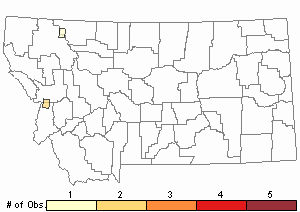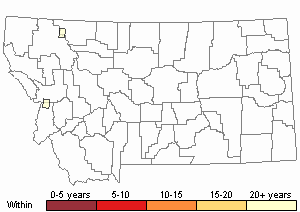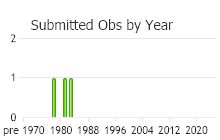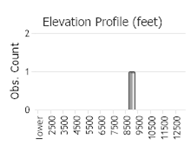View in other NatureServe Network Field Guides
NatureServe
Montana
Utah
Wyoming
Idaho
Wisconsin
British Columbia
South Carolina
Yukon
California
New York
Curved Dry Rock Moss - Grimmia incurva
Other Names:
Curved Black Rock Moss
General Description
Plant: Rounded cushions. Green to black-green. Stems 1.0-2.0 cm tall. Stem X-S with a central strand.
Leaf: When dry, leaves are incurved and mildly contorted. When moist, leaves spread. Oblong to linear-lanceolate, 2.5-4.5 x 0.3-0.5 mm, keeled, and tapers to a slender and acuminate apex that is often hyaline. Awn short and often mucronate (use hand-lens). Both margins plane or one/both sides recurved proximally. Costa ends before apex and projects on abaxial side (keeled).
Leaf Cells: Basal laminal cells near costa are long-rectangular, slightly sinuose, thick-walled. Basal laminal cells near margin are short- to long-rectangular and thin-walled. Median laminal cells are rectangular, nodulose, and thick-walled. X-S: distal laminal cells are 1-layered except margins and apex are 2-layered. Costa X-S: distally semi-circular in outline (keeled).
Diagnostic Characteristics
Its distinctive characteristics include dark, round cushions with linear, contorted leaves in shaded, sub-alpine habitats. The awns are noticeable only with a hand-lens. Its habit is similar to Dicranowesia crispula.
Range Comments
Greenland; Canada: AB, BC, NB, NL, YT; USA: CA, CO, ME, NH, NY, OR, SD, WA; Eurasia (FNA 2007). In Montana: Flathead and Ravalli Counties (Elliott 2016).
Observations in Montana Natural Heritage Program Database
Number of Observations: 3
(Click on the following maps and charts to see full sized version)
Map Help and Descriptions
Relative Density

Recency



 (Observations spanning multiple months or years are excluded from time charts)
(Observations spanning multiple months or years are excluded from time charts)
Habitat
Shaded, damp acidic rock. Moderate to high elevations (1,640 – 8,200 feet). It prefers shaded microsites in the sub-alpine. It is uncommon in the continental interior.
Reproductive Characteristics
Dioicous. Seta is 1.5-2.0 mm tall, arcuate, and asymmetrically attached to base of capsule. Capsules are occasionally found, emergent to exserted, yellowish, smooth or little wrinkled when dry, oblong-ovoid to cylindric.
Gemmae absent on leaves.
Stewardship Responsibility
References
- Literature Cited AboveLegend:
 View Online Publication
View Online Publication Elliott, J.C. and A.K. Pipp. 2018. A Checklist of Montana Mosses (1880-2018). Updated 3 January, 2020. Montana Natural Heritage Program, Helena, Montana. 73 pp.
Elliott, J.C. and A.K. Pipp. 2018. A Checklist of Montana Mosses (1880-2018). Updated 3 January, 2020. Montana Natural Heritage Program, Helena, Montana. 73 pp. Flora of North America Editorial Committee, eds. 2007. Flora of North America North of Mexico. Volume 27. Bryophytes: Mosses, Part 1. Oxford University Press, Inc., NY. xxi + 713 pp.
Flora of North America Editorial Committee, eds. 2007. Flora of North America North of Mexico. Volume 27. Bryophytes: Mosses, Part 1. Oxford University Press, Inc., NY. xxi + 713 pp.
- Additional ReferencesLegend:
 View Online Publication
View Online Publication
Do you know of a citation we're missing? Elliot, J. C. 1993. Second checklist of Montana mosses. Unpublished report. U.S. Forest Service, Region 1. Missoula, MT. 45 pp.
Elliot, J. C. 1993. Second checklist of Montana mosses. Unpublished report. U.S. Forest Service, Region 1. Missoula, MT. 45 pp. Lawton, E. 1971. Keys for the Identification of the Mosses on the Pacific Northwest. Reprinted from 'Moss Flora of the Pacific Northwest'. Published as Supplement No. 2 of the Journal of the Hattori Botanical Laboratory. Nichinan, Miyazaki, Japan. 66 pp.
Lawton, E. 1971. Keys for the Identification of the Mosses on the Pacific Northwest. Reprinted from 'Moss Flora of the Pacific Northwest'. Published as Supplement No. 2 of the Journal of the Hattori Botanical Laboratory. Nichinan, Miyazaki, Japan. 66 pp. Lawton, E. 1971. Moss Flora of the Pacific Northwest. Hattori Botanical Laboratory. Japan: Yamabuki-cho, Shinjuku-ku, Tokyo. 362 pages plus appendices.
Lawton, E. 1971. Moss Flora of the Pacific Northwest. Hattori Botanical Laboratory. Japan: Yamabuki-cho, Shinjuku-ku, Tokyo. 362 pages plus appendices.
- Web Search Engines for Articles on "Curved Dry Rock Moss"





